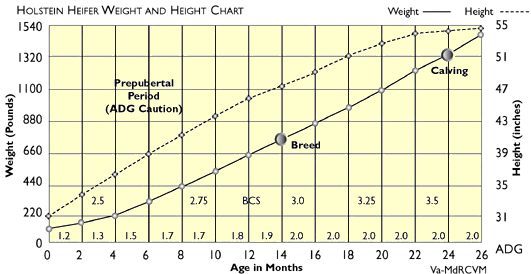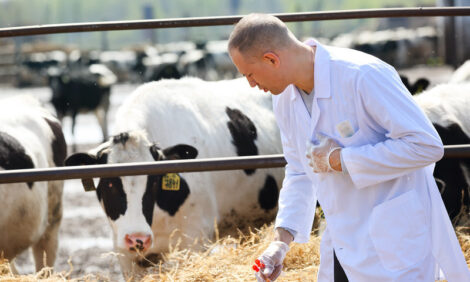



Early Heifer Development and Colostrum Management
By Tom Bailey, Extension Specialist, Virginia-Maryland Regional College of Veterinary Medicine; Julia M. Murphy, Virginia-Maryland Regional College of Veterinary Medicine; and Robert James, Professor of Dairy Science, Virginia Tech. Raising dairy replacement heifers is expensive. In fact, if the dairy is divided into different enterprises (eg. labor, feed cost for lactating cows, facilities, etc.), rearing replacements is the second largest cost, behind feed cost for lactating cows. The percentage will vary from farm to farm, but approximately 9% to 20% of the expenses incurred will involve rearing and developing heifers. Therefore, heifers should represent a sound investment, as their impact on future herd profitability is enormous.
Raising dairy replacement heifers is expensive. In fact, if the dairy is divided into different enterprises (eg. labor, feed cost for lactating cows, facilities, etc.), rearing replacements is the second largest cost, behind feed cost for lactating cows. The percentage will vary from farm to farm, but approximately 9% to 20% of the expenses incurred will involve rearing and developing heifers. Therefore, heifers should represent a sound investment, as their impact on future herd profitability is enormous. Priorities given to these animals are often negligible. Goals should be set. These goals should include heifers (1) that will calve around 24 months old, at a weight of 1350 pounds, adjusted to an approximate 1225 pound post-calving weight, with a wither height of 54 inches, and a body condition score of between 3.25 and 3.5 (5 Point scale) (Figure 1). Rearing goals should also include (2) having 80 to 85% of the heifers born reaching the lactating herd; and (3) having heifers that will produce 200 lbs more milk than last year's heifers. These goals are attainable, and they should decrease expenses and increase profits for the dairy.
A successful replacement rearing program must be a conscious effort with priority placed on heifer rearing. If the farm management is not doing an adequate job of raising heifers, serious consideration should be given to contract growing outside the farm. Several factors can dramatically reduce replacement-rearing cost and increase potential profits for the producer: (1) maximizing immunity from colostrum to minimize mortality and sickness; (2) formulating rations for specific weight gains during strategic periods of development, and avoiding over-fattening prior to puberty because it impairs mammary development; (3) formulating rations for an average daily gain of 1.8 lb. for Holstein heifers; (4) using AI sires ranking in the top 20% for (PTA$) to optimize genetic improvement; (5) monitoring age, body weight, wither height, body condition score, as well as peak milk and ME milk yield of first lactation heifers to evaluate management at first calving; and (5) controlling the size of the replacement herd by calving heifers at 24 months and raising no more than needed.

*ADG (average daily gain) stratified by months of age.
^BCS (body condition score) stratified by growth periods.
The Newborn
Getting calves started correctly is the first step toward raising healthy replacements. Colostrum management, good nutrition, and keeping young calves clean, dry and comfortable are the keys to healthy replacements. Colostrum quality and quantity is the first step in this important foundation, as calves are born without essential protection. All colostrum is not created equally. Colostrum can vary considerably from cow to cow. Based on research at the Virginia Tech dairy facility, individual cows have varying concentrations of immunoglobulin in their colostrum, some with levels too low to provide adequate protection in the calf. Colostrum can be easily collected and evaluated for immunoglobulin status (antibody protection passed through the colostrum from the dam to the calf) using a colostrometer.
Keeping check on colostrum quality with a colostrometer insures that adequate levels of immunoglobulins are present. However, for an accurate reading, colostrum should be at room temperature and not cold or warm. The colostrometer measures the colostrumÜs specific gravity and will subjectively grade its quality as either good, fair, or poor. Colostrum from older cows should be utilized and fed to calves born from first calf heifers. This may be necessary, as first calf heifers have not been exposed to numerous disease causing organisms and may not have the level of immunoglobulin protection that older multiple vaccinated cows have. For storage, colostrum can be refrigerated for 4 to 5 days, or placed in plastic bags at -20( C (freezer), or soured with propionic acid. Thaw colostrum in warm water, as extremely high thawing temperatures can destroy the protein content of the immunoglobulins. Colostrum may be frozen for months (10 to 12) and should be properly labeled with the contributing dam's identification number, the date collected, and the immunoglobulin status (good, fair, poor) of the colostrum. Only "good" category colostrum should be fed the first 24 hours of the calf's life, using "fair" only if "good" is unavailable. "Poor" should be used as milk replacer for calves.
Colostrum should be hand fed to insure adequate intake of 8 to 10% of the calf's body weight in the first 12 hours of life. The typical 80 to 85 lb calf should receive 2 quarts in the first 2 hours after birth and 2 quarts more 6 to 8 hours later. This feeding in the first 12 hours of life is probably the most essential, as the absorptive pores in the stomach and intestines for colostrum are reduced by one-third after 6 hours of age. An additional 4 quarts should be divided into 2 feedings over the next 12 hours to bring the total intake of high quality colostrum to 2 gallons within the first 24 hours of age. Hand feeding insures the calf is getting ample intake. This can be accomplished with a nursing bottle or an esophageal feeder. If calves are left to nurse on their own, research has also shown that 25 to 40% of the calves do not receive adequate amounts of colostrum with protective immunoglobulin levels against agents that cause primary digestive (diarrhea) and respiratory problems (pneumonia).
Another valuable tool in assessing the colostrum management of farm personnel is to have your veterinarian monitor immunoglobulin status of the calf with the routine use of either the refractometer for total serum protein, the sodium sulfite precipitation test, the zinc sulfate turbidity test, or radial immunodiffusion test. The refractometer is a small hand-held instrument used to monitor a random sampling of the calves during farm visits or monthly herd checks. Any time calf health is a concern, checking colostrum management and immunoglobulin status is the first step in the investigation process. Refractometer readings are made using serum from the calf between 2 and 10 days of age.
Serum protein readings should be above 5.5 gms/dl and preferably above 6 gms/dl. This is an indication the calf received an adequate amount of high quality colostrum. Calves monitored at the Virginia-Maryland Regional College of Veterinary Medicine had the highest level of protection when blood protein levels were above 6 gms/dl. If levels fall below 5.5 gms/dl, calves are questionable for adequate protection. With levels below 5 gms/dl, failure of passive transfer (inadequate levels of protection) has occurred and the calf is susceptible to disease causing bacteria leading to calf diarrhea and dehydration, joint ill, and respiratory diseases (pneumonia). When levels of protective immunoglobulins fall below 5.5 gm/dl, an evaluation of calf management should be performed with all associated farm personnel. Several other factors, primarily extremes in temperature (hot or cold) and dystocia, can adversely affect immunoglobulin absorption and uptake by the calf.
Calves should have their navels dipped in an iodine solution. This practice should be repeated every 12 hours for 3 treatments, or until the navel cord appears dry. Navel dipping, however, aids only in decreasing the incidence of umbilical infections. A clean, dry, comfortable environment plays a much greater role in calf health. The primary objective of the calving and young calf environment should be aimed at reducing the number of disease-causing organisms the calf is exposed to. If calf death is followed by a postmortem examination, and if joint ill, pneumonia, or intestinal upsets (diarrhea) are found, essentially all cases can be traced back to inadequate colostrum intake, unsanitary calf rearing facilities, or poor milk replacers - problems easily corrected through good management.
June 1999



